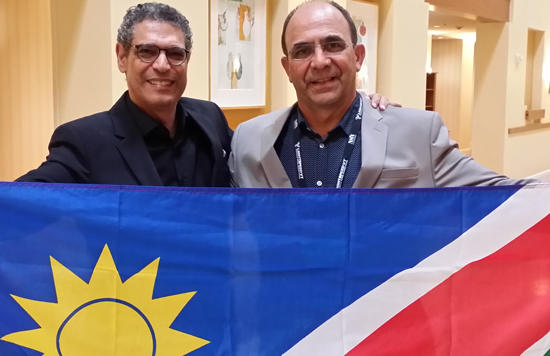
Tourism saturated – NTB
 The Namibia Tourism Board CEO, Digu //Naobeb believes there is market saturation in the local tourism industry and supply is now outstripping demand as evidenced by the sluggish growth recorded in recent years.
The Namibia Tourism Board CEO, Digu //Naobeb believes there is market saturation in the local tourism industry and supply is now outstripping demand as evidenced by the sluggish growth recorded in recent years.
In an exclusive interview with the Economist this week, //Naobeb said while the number of tourism related businesses had increased to 3600 up from 640 in 2004, the arrival figures have grown at a nominal rate.
//Naobeb added that average occupancy rates of all types of accommodation establishments in the country have remained subdued in recent years, recording figures below 50% on average.
“What we are observing is that we have reached maturity levels, the figures have remained constant for a number of years now.
“… if you compare back in 2004 when we first registered tourism businesses, we had 640. Now we are sitting with about 3600 businesses while the arrival figures continue to grow at a very nominal rate,” //Naobeb said.
Namibia recorded a 0.24% increase in international tourism arrivals between 2009 and 2010, and in 2011, the NTB CEO estimates a growth figure of between 0.4% to 1%.
Besides saturation, //Naobeb said the industry was also suffering from the effects of the Eurozone debt crisis. The Eurozone area is Namibia’s traditional source market for tourism.
“The economic crisis (Euro debt crisis) has an impact on this one as well because it impacts our traditional source markets such as Italy, the United Kingdom and France but not so much Germany,” he said.
Compared to 2010, average occupancy rates in Bed and Breakfast establishments remained static at 25% in 2011 during the period January to October, while the occupancy rates of Hotels (32% to 31%), Hotel pensions (37% to 36%) and Tented lodges (48% to 34%) recorded a decline.
But according to the NTB CEO, all hope is not lost as those industry players that have been concentrating on the domestic market have yielded positive results. Accommodation establishments that performed very well in 2011 included: Rest camps (29% to 42%), Self caterings (17% to 21%), Tented camps (41% to 43%), Lodges (29% to 31%), Guest farms (15% to 17%) and Backpackers (20% to 21%).
As a result of this, the average occupancy figures for all accommodation establishments between January and October 2011 was 30% compared to 27% in 2010 during the same period.
“So if the accommodation sectors have been concentrating on international visitors of course they have been seeing almost not really high levels of profits, especially if you are concentrating on the source markets where the Euro debt crisis has been emanating from. However those that have been concentrating on the domestic market through promotions and discounts are looking at positive margins.
“It is known by research that in difficult times, the local tourists carries the tourism industry. For example in Zimbabwe, despite the travel ban (by most Western countries), the tourism industry there is flourishing and there are no foreclosures of businesses.”
Going forward, the NTB boss said they were revamping their marketing strategy in order to have more tourists coming into the country.
“What we are now trying to do with the current traditional markets is to try and identify the people that have the potential to travel so that our marketing messaging or activities are targeted at those people. We do that by working with the main travel agencies and tour operators in Europe.
“We are doing what we call smart partnerships with the suppliers in Europe and Air Namibia to ensure marketing activities generate actual sales.
“Secondly, we are now trying to diversify the dependence on the traditional source markets to include countries like the USA, China, Scandinavian countries, the Baltics and the United Arab Emirates and in Africa besides South Africa, we are now embarking on a marketing strategy in Botswana.”
He said the Namibia Tourism Board has also started looking at creating synergies and networking with foreign suppliers in the new markets that they are entering, a move that has seen the NTB focusing on road shows and networking events in those source markets lately.
In addition, the NTB is also looking at venturing on online marketing using social media platforms as well as exploring the possibility of running adverts on one of the international channels to stimulate interest in the country.
“To achieve the best for Namibia, you have to strike a balance between the below line marketing and the above the line marketing. The above the line marketing and the social online option is to capture the potential tourists interests in other countries and continents where we don’t have our own presence.”
//Naobeb added that there was need to change the approach in which the country had been marketed to overseas tourists to stimulate further interest in the country.
“We have been mainly focusing on our leisure and holiday tourism which is based on landscape scenery and wildlife but we need to now look at developing other products like hosting of events, adventure travel, cultural tourism (MICE).
“We haven’t also been proactive on cruise ships. They have been docking in Walvis Bay but I think we are not making much of an effort to work closely with those cruise-liner companies for tourists who are on board to explore Namibia while the ship is moored in the harbour.
“So these are the kind of things we need to concentrate on and possibly developing seaside or coastal resorts.”











































